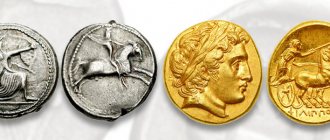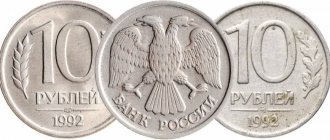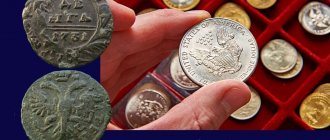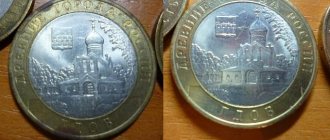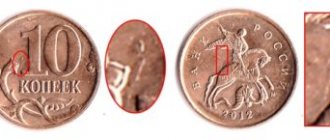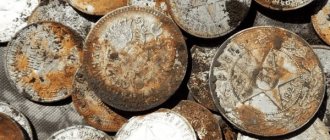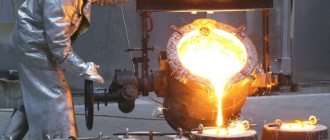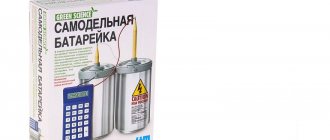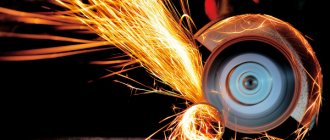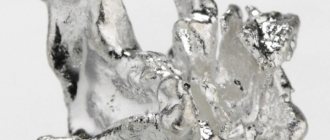Other articles Silver ten-kopeck coin of 1713 (Hermitage exhibition)
The first Russian coins appeared more than a thousand years ago, but for almost the entire period of history, the basis of the money supply was silver. In pre-Mongol Rus', instead of the word “money”, which has Tatar roots, the word “silver” was even used, which emphasizes the importance of silver in monetary circulation. During the period of feudal fragmentation, the first copper coins appeared - pulas, but they had very limited circulation. Gold coins arose under Ivan III, but for a long time they were reward coins and almost did not participate in circulation. And only under Peter I, gold and copper were firmly included in the monetary system, while copper coins played the role of change, and gold coins served more as a means of accumulation or for carrying out large financial transactions. The purchasing power of the coins slightly exceeded the cost of the metal, so the goal of the counterfeiters was not to make copies of the coins, but to underestimate the fineness, reduce the weight, and cut off the metal from the real coin. In the 20s of the 20th century, various alloys replaced expensive metals, and coins turned into coin-shaped banknotes. Gold and silver are now used only in the manufacture of collectible and investment coins. Palladium and platinum have also been added to them, but their share in the production of collectible coins is very insignificant.
Silver
The first silver coins “srebreniks” began to be minted under Prince Vladimir the Great around the 990s.
The period of independent Russian coinage did not last long, and already in the second half of the 11th century, the “Coinless Period” began, when silver bars were used as a means of payment. The issue of coins was resumed during the reign of Dmitry Donskoy; from that time on, there were coins of only two denominations - denga and polushka, all of them were silver. Under Ivan the Terrible, the first kopecks appeared, which became the basis of monetary circulation. In 1654-1655, the first ruble coins were issued, which were also made of silver, but the full circulation of the silver ruble had to wait another half century. Peter's monetary reform significantly transformed the appearance of coins, added many new denominations, but silver coins in denominations from a kopeck to a ruble (later from 5 kopecks to a ruble) were still the main ones. It was possible to completely abandon the use of precious metal in monetary circulation only under Soviet rule. The last silver coins date back to 1931 (10, 15 and 20 kopecks), fifty kopecks disappeared in 1927, and rubles even earlier - in 1924. Silver bullion coin
In 1977, for the upcoming Olympics, collectible silver coins of improved minting quality were issued; in subsequent years, the production of silver commemorative and anniversary coins was continued. Currently, several dozen types of collectible and investment coins are issued annually; they can be purchased in banks at a special price. The weight of such coins ranges from 15 grams to 5 kg.
| Parameter | Meaning |
| Color | Silver white |
| Chemical designation | Ag |
| Melting temperature | 960°C |
| Density | 10.5 g/cm3 |
| Mohs hardness scale | 2,7 |
Old Russian state (mid 9th - mid 15th centuries)
During this time period, not only metals, but also furs were used as money. Judging by the surviving historical information, in the 9th–10th centuries a warrior received 8–9 Kyiv hryvnia per year. It is worth recalling that the hryvnia is a silver bar. One such Kiev hryvnia corresponded to more than two hundred silver dirhams.
In addition, clippings of silver dirhams were in circulation in Rus'. For example, one such cutting weighing 1.04 grams, circulating in the lands of Northern Rus', was equal to 1/200 of a silver hryvnia.
Also, in addition to furs and silver, gold was also used as money.
Gold
Golden chervonets of Peter I (Hermitage exhibition)
The first Russian gold coins appeared at about the same time as silver coins - at the end of the 10th century, but their production had a very small volume, and under subsequent rulers it stopped altogether. Under Ivan III, the minting of gold grant coins began, which were awarded to outstanding architects, builders, and also for various merits. These coins were not a full-fledged currency, although they came into circulation from time to time. Since the era of Peter I, the gold coin has occupied a special niche in monetary circulation; 2-ruble coins and chervonets coins without indicating the denomination are made from gold. Under Elizaveta Petrovna, 5 and 10 rubles appear. The gold coin remained a hard currency, an alternative to constantly depreciating banknotes. During the Civil War, they (especially the Nikolaev 10 rubles) had a high exchange rate among the population and were in great demand. In 1923, a large edition of Soviet gold chervonets was issued, the size and weight of which coincided with the Tsar's 10 rubles. Their goal was to reinforce the paper chervonets, which had a gold backing. The population did not receive such coins, and they were not accepted abroad because of Soviet symbols, so the issue was not continued, and the bulk of the circulation was melted down. In 1975-1982, new-made chervonets were issued with exactly the same images, but different dates; currently they serve as investment coins. Since 1977, in addition to collectible silver coins, gold coins have been minted. The production reached its greatest volume in 2010-2013, after which it began to decline. However, several types of gold coins are currently produced annually and can be purchased from banks at special prices. In addition to this, investment gold coins of UNC quality are issued, the cost of which is slightly lower than collectible ones.
| Parameter | Meaning |
| Color | Golden |
| Chemical designation | Au |
| Melting temperature | 1064.43°C |
| Density | 19.621 g/cm3 |
| Mohs hardness scale | 2,5 |
Coin history
The history of coins dates back before the birth of Christ; as early as 1000 BC, the Chinese used a type of metal token for payment. Human civilizations have long used metals as a medium for exchange. In addition to their durable properties, metals are easy to melt and cast.
These artifacts were designated "shovel" and "key" money due to their resemblance to a digging tool and to the modern Yale key. Both types had denominations and were cast from molds. Although the ancient Egyptians did not mint coins, they used gold weights and rings to trade products and services.
The first recording of Western coins did not occur until 700 BC. , in Western Asia Minor. The evidence is that coins made from a natural alloy of gold and silver called electrum were found in the foundations of the Temple of Artemis at Ephesus on the Aegean Sea. King Croesus of Lydia, who reigned from 560 to 546 BC. E., was credited with creating a bimetallic system of pure gold and pure silver currency discs. These early coins usually bore the imprints of animals such as bulls, birds, insects or mythical creatures. Vegetable engravings are also popular.
The dies were imprinted on one side of the coins using a tool bearing that particular design. During this period, coin design was elevated to an artistic form, and the carefully captured engravings on tokens were given high status. Many Greek cities vied to have the most beautifully designed coins.
Alexander the Great built mints throughout his kingdom, from Macedonia to Babylon. He established uniform weights and types. It was during Alexander's reign that the coin painting became popular. The portraits were of rulers, gods and goddesses. By the fourth and fifth centuries AD, engravers in Italy, and especially Sicily, were generally recognized as experts in coin design. Their skill was so revered that engravers began to sign their work.
Before the advent of the industrial age, coin striking was done manually. A round bolt of metal was placed over an anvil, which was equipped with a stamp. Another stamp was attached to the pestle, which was then placed on top of the empty one. The coin maker held the pestle in place with one hand and then hit it with a 60cm hammer from above. With such an impact, a pressure of 7 tons was generated and allowed the stamp to appear on the workpiece. The high relief characteristic of early Greek coins sometimes required two or three strikes to achieve the desired effect. Heating the workpiece before striking often reduced the number of strokes required. This method allowed one coin to be removed every two seconds.
Copper
5 kopecks 1802 (Hermitage exhibition)
Copper coins - pulas - were made in Novgorod and Tver back in the 15th century; they were small and had an irregular shape, just like silver coins of that time. It is still unknown exactly in what ratio they were equated to silver; there are different opinions: from 20/1 to 150/1. With the unification of Rus', local types of coins disappeared, and with them the pools. Copper monetary circulation was revived under Tsar Alexei Mikhailovich, when they tried to equalize coins made of silver and copper that were identical in size and weight. This caused a strong drop in the exchange rate of copper coins and the famous “Copper Riot”; the idea had to be abandoned. Since 1700, the first full-fledged copper coins of a round shape were issued, which, compared with the silver “scales” that circulated in parallel with them, were significantly ahead of their time. The high quality of copper coins made it possible to partially introduce copper into circulation and replace scarce silver with it. For more than 200 years, copper coins served as change, the denominations were low: from half a half to 5 kopecks (sometimes a coin with a denomination of 10 kopecks was produced). In 1924, when the Soviet ruble finally strengthened, copper coins in denominations of 1, 2, 3 and 5 kopecks (since 1925 - half a kopeck) came into circulation, but within two years they began to be replaced by more durable and cheaper bronze ones. In the modern history of Russia, a copper coin was also issued - 5 rubles of the 1997 model, which had a copper base and plating made of cupronickel alloy. Since 2009, they have been replaced by coins with a steel base, but copper ones can still often be found in circulation.
| Parameter | Meaning |
| Color | Golden pink |
| Chemical designation | Cu |
| Melting temperature | 1083.55°C |
| Density | 8.92 g/cm3 |
| Mohs hardness scale | 3 |
Russian state (15th - 17th centuries)
During these times, the state monetary system developed and already consisted of the ruble, half, hryvnia, penny, kopeck, money, half money and pula. Despite this, silver continued to serve as the main metal used in trade and payment of salaries. The pools, in turn, were made of copper.
During the monetary reform of Elena Glinskaya, a standard appeared for the minting of Moscow money - “Moskovka” and “Novgorodka” - Novgorod money. Moreover, one “Novgorodka” corresponded to two “Moskovkas”. On the obverse of the Novgorod money, by the way, a horseman with a spear was depicted, which is why it was nicknamed “kopek”. From one silver hryvnia they were minted in quantities of 300 pieces with an average weight of 0.68 grams. Silver “Moskovki” weighed half as much - 0.34 grams. One hundred “Novgorods” constituted a Moscow counting ruble. Over time, the heavier penny pushed the money into the background.
One ruble was divided into half, hryvnia and altyn. Poltina was half a ruble, the hryvnia included 20 money, and the altyn included 6 money.
Kolyvan copper
Siberian 10 kopecks (Hermitage exhibition)
When gold and silver were isolated from the copper ore of the Kolyvan deposit in Altai in the second half of the 18th century, the resulting copper remained with a small admixture of the precious metal. It was impossible to visually distinguish Kolyvan copper from ordinary copper, but the gold content in it reached 0.01% and about 0.8% silver. The estimated price of the metal was 24.24 rubles per pound, while the cost of ordinary copper was 6 rubles per pound. The President of the Mint Department, I. Schlatter, proposed minting special “Siberian” coins from this copper, which would be one and a half times lighter than ordinary ones. For the issue, the Suzunsky Mint is created near modern Barnaul. Minting lasted from 1763 to 1781, denominations from half a half to 10 kopecks were issued. The coins had completely different images and the coat of arms of Siberia. Just a few years after the start of production, the technology for separating metals was modernized, and the content of precious impurities became completely insignificant, but the weight of Siberian coins was not increased. The end of production was a consequence of rampant counterfeiting; criminals made coins from ordinary copper, which was four times cheaper, while receiving huge profits.
Industrial production of coins in a factory
Stamp molding and engraving
When a new coin was introduced into service, sculptors at the mint developed a set of designs. Once one specific sketch is approved and refined, the sculptor creates a clay model. The model can be anywhere from three to twelve times larger than the real coin.
Plaster is poured over the clay model to create a negative or reverse plaster model. The words of the inscriptions are carved into the plaster in a mirror order. The sculptor repeats this process several times until the plaster model is perfect.
Next, a durable rubber mold is made by pouring epoxy resin into a plaster mold. An epoxy mold is mounted onto the transmitter. At one end of the transmitter-engraver, a stylus traces the epoxy mold. As the stylus is moved, the ratio bar in the middle of the engraver reduces the design to the actual size of the coin. This reduced size communicates with a carbide tool at the opposite end, which then cuts the structure into a steel blank. This produces a stamp which the sculptors examine and remove any imperfections.
Creating work stamps
The heat-treated metal is placed under a computer-controlled lathe where it is smoothed and polished into a precisely measured piece. The main hub is pressed into the die. The result is called the "master stamp". The main die is used to create working hubs and working matrices. The master hubs and matrices are then placed into storage.
Punching blanks
A suitable spool of metal is fed through an extinguisher, which knocks out circular discs corresponding to the dimensions of the coin to be minted. Workpieces are cut at a speed of 400 strokes per minute. The remaining scrap metal is crushed and recycled for future use.
Annealing and polishing of workpieces
The blanks undergo another annealing process and are then placed in industrial washers and dryers. The lubricants used in these various processes cause the workpieces to stain and oxidize. The blanks are then placed in rotating tanks or barrels filled with an acidic pickling agent. After this procedure they become polished.
Sorting coin blanks
The blanks are sifted through a "riddler", a metal sheet equipped with holes that correspond to the exact size of the specific coin to be minted. In this way, defective coin discs are selected.
Coin defeat
Ideal blanks, stamped with patterns and inscriptions, are transferred by a conveyor belt to a case for pressing. A steel collar is inserted into a press around one of the dies. The reverse side cube is loaded into the upper arm of the press. Hundreds of tons of atmospheric pressure push the plug into the collar. At the same time, the top die is pushed into the collar and onto the form. The impact creates an impression on both sides of the workpiece. The press releases the newly measured coin and it moves along a conveyor belt to the inspection line.
In some cases, the collar is grooved to create ribbed edges on the coin. Otherwise, the grooves are created after impact, on a tool called a digging mill. Press sizes range from a single container to units that mark four coins at a time. Single-cycle presses typically mark 400 coins per minute, with loads up to 180 tons. Several presses can produce 120 coins per minute under a pressure of 250 tons.
Checking and sorting
The press operator inspects each batch of new coins using a magnifying glass. The coins are moved through another riddler, who disassembles the discs that have become warped or dented during the astonishing process.
Counting and packing
An automatic counting machine dispenses a predetermined number of coins and drops them into large canvas bags. The bags are sewn shut, loaded onto pallets, and then moved by forklifts to storage facilities.
Platinum
Platinum coin with a face value of 12 rubles (Hermitage exhibition)
At the end of the reign of Alexander I, significant deposits of a metal unknown at that time - platinum - were found in the Urals. With the coming to power of Nicholas I, the minting of platinum coins in special denominations was organized: 3, 6 and 12 rubles. The fact is that, to save money, the same equipment and presses were used in the manufacture of circles as in the manufacture of silver blanks. The estimated cost of platinum was 12 times higher than silver, and its density was 2 times higher. Therefore, 12 rubles had the size of 1 ruble, 6 rubles 50 kopecks, and 3 rubles 25 kopecks. Coins were produced en masse in 1828-1845, but again counterfeiters, who used ordinary silver as a raw material, became an obstacle. Moreover, there were cases of fraud when regular silver coins were issued instead of platinum coins (it was easy to confuse them in the dark). After the end of the issue, all the platinum stored in the treasury and the coins that were collected from the population were sold to England. The revival of platinum coinage occurred already in Soviet times; these were collector's issues of improved quality, dedicated to various events. Production was discontinued in 1995.
| Parameter | Meaning |
| Color | Steel gray |
| Chemical designation | Pt |
| Melting temperature | 1769°C |
| Density | 21.5 g/cm3 |
| Mohs hardness scale | 4,3 |
Table of the value of coins 10 rubles
The table in the next photo shows a list of coins by year. Prices are given for SPMD and MMD options. This is the average cost for tens of them in good condition without significant abrasions or darkening.
As can be seen from the table, dozens of MMDs that were issued in the first five years of minting are valued slightly more than their face value. And 10 rubles 2011, 2012 and 2016 with the SPMD sign, although they are expensive, these issues are trial ones, they were not approved for mass circulation, so it will not be possible to find them among the circulating change.
Therefore, let's pay attention to rare and valuable varieties, as well as defective money.
Palladium
Palladium is very similar to platinum, but has a much lower density, close to silver. Palladium coins were produced only in 1977-1995, these were collector's issues of improved quality PROOF and Uncirculated.
| Parameter | Meaning |
| Color | Silver white |
| Chemical designation | Pd |
| Melting temperature | 1554°C |
| Density | 12.02 g/cm3 |
| Mohs hardness scale | 4,8 |
What is the reason for changing the metal of bimetallic coins?
Only the Central Bank can answer this question precisely, but it remains silent and has not even warned about a change in materials for the minting of Russia’s most popular anniversary and commemorative coins. At the same time, on various numismatic forums and groups in social networks. There is a lively discussion on this topic on the networks. Most of those discussing are inclined to the version of banal cost savings. After all, steel is a ferrous metal and is much cheaper to mine and produce than brass and cupronickel, which are non-ferrous.
Actually, there are simply no other versions of why a change was needed, not precious, but noble metals to ordinary steel.
Copper-nickel alloys
Silver coins were replaced in 1931 by 10, 15 and 20 kopecks made of a new material - a copper-nickel alloy. As the name suggests, it is based on copper and nickel with the addition of a small proportion of other metals. There are different alloys, but they are all quite resistant to environmental influences and have a silver color. The copper content reaches 90%, but can be significantly less; the nickel content usually does not exceed 20%. From 1997 to 2009, coins of 1 and 2 rubles were made from nickel silver, and 25 rubles from 2011 from cupronickel. There was also a cupronickel insert for bimetallic 10 rubles until 2022. The most common types of copper-nickel alloy:
cupronickel - 68-93% copper, 5-30% nickel, up to 0.8% iron, up to 1% manganese;
nickel silver - 5-35% nickel, 13-45% zinc, the rest is copper; Monel - up to 67% nickel, up to 38% copper. Characteristics of cupronickel:
| Parameter | Meaning |
| Color | Silver |
| Alloy composition | 68-93% copper, 5-30% nickel, up to 0.8% iron, up to 1% manganese |
| Chemical designation | NiFeMn |
| Melting temperature | 1170°C |
| Density | 8.8-9 g/cm3 |
| Mohs hardness scale | 3-3,5 |
Main metal of coins of the Russian Federation
If we are talking about everyday items that have recently left the mint, then they are made of steel. It is an alloy of iron with the addition of carbon that is currently the basis for the production of negotiable banknotes of the Russian Federation. Considering that coin steel contains up to 1.7% carbon, we are talking about high-carbon steel.
To make coins wear-resistant and resist corrosion, they are plated. For the most recent issues of denominations below the ruble, this is brass. Ruble denomination coins are plated with nickel. All steel coins have pronounced magnetic properties. Above is a steel five made on a workpiece that erroneously avoided galvanizing.
Bronze
Bronze replaced the more expensive copper in Soviet-era currency. Another advantage of bronze is its higher resistance to aggressive environments. Bronze contains a large part of copper (up to 90%) and other metals (tin, aluminum, beryllium, silicon, lead). Depending on the metal it contains, bronze is called tin (or simply bronze), aluminum, etc. Bronze has a reddish-golden color, more yellow than pure copper. It quickly fades when exposed to air, forming a protective film that prevents further oxidation. The first bronze coins came out in 1926, using aluminum bronze. After 1957, the use of bronze in coin production ceased, and was replaced by a copper-zinc alloy. Since the 1990s, bronze has been used to make rings or inserts for bimetallic coins.
| Parameter | Meaning |
| Color | Golden yellow |
| Alloy composition | 75-90% copper, 10-25% tin (or aluminum, silicon, beryllium, lead) |
| Chemical designation | CuSn, CuAl, CuSi, CuBe, CuPb |
| Melting temperature | 930—1140° C |
| Density | 7.5-8.8 g/cm3 |
| Mohs hardness scale | 2,5-3 |
Brass
Brass differs from bronze in its lower copper content and the presence of zinc as the second component of the alloy. It is much cheaper than bronze and pure copper. In the production of Russian coins, brass was used mainly as a coating for steel blanks (1 and 5 rubles 1992, 50 rubles 1993-1995, 10 and 50 kopecks since 2006), but in 1997-2006 10 and 50 kopeck coins were made of pure brass In addition, some denominations in the sets of commemorative coins of 1995-1996 and the ring for the bimetallic ten of 2000-2016 were brass.
| Parameter | Meaning |
| Color | Golden yellow |
| Alloy composition | 60-85% copper, 15-40% zinc |
| Chemical designation | CuZn |
| Melting temperature | 880—950° C |
| Density | 8.3—8.7 g/cm3 |
| Mohs hardness scale | 3,5-4 |
Coin tradition
In terms of coin circulation, Russia is no exception and, although the famous penny died out not so long ago due to its meager value, metal money exists in Russia, albeit in other denominations.
Coin traditions around the world are not much different. The only thing that changes is the design of the coins and their composition, or rather the alloy from which they are made.
Copper-based alloys have long been traditional throughout the world. There is nothing surprising in this, since initially, after the transition from minting money from precious metals, it was copper that reigned in the coinage. Copper money existed as a small change back in the days of ancient Rome.
Nickel
There are known test 2-kopeck coins from 1883, found in 1887 at the St. Petersburg Mint in the amount of 68 pieces. Later a note was found from the head of the mint N.P. Vollendorf, which mentions the proposal of the Ural industrialist Permikin to mint nickel coins from the metal mined in his mines. It was planned to use almost pure nickel, which had minor impurities due to the impossibility of their isolation. In 1911 and 1916, the idea of minting nickel coins was returned to, but things did not go beyond trial issues.
| Parameter | Meaning |
| Color | Silver white |
| Chemical designation | Ni |
| Melting temperature | 1453°C |
| Density | 8.902 g/cm3 |
| Mohs hardness scale | 3,8 |
Valuable varieties by year with descriptions and prices
Here we will look at how much 10 rubles cost in different years of production.
2009
The list of 10 rubles that are expensive is headed by coins issued in 2009, in which the mint’s trademark is located in a non-standard place (moved towards the letter “I” or located between the letter and the eagle’s paw). The price of 10 rubles reaches 2 thousand rubles. But these are exactly what an ordinary person can actually find in his wallet. According to statistics, one rare coin is found among five hundred standard monetary units.
2010
If in the first year of issue tens were minted only in Moscow, then from the next year St. Petersburg also joined the process. SPMD produced a number of copies in which the protective lines in the inner zone of the zero touch the walls of the digit. Today such copies can be sold for thousands of rubles apiece.
2011
In 2011, the production of ten-ruble coins at SPMD was officially discontinued. However, several trial copies did end up in circulation. Today they are considered one of the most expensive coins in Russia. Their cost can reach up to 300 thousand rubles.
2012
This year's rare tens are those whose outermost lines inside the zero circle were very thick. The price of such a monetary unit in some years reached 30 thousand rubles. However, recently some numismatists have suggested that the coin is an ordinary fake. Therefore, trading on it was suspended in 2022. It can also be sold profitably in a private transaction, but the price of 10 rubles will be significantly lower.
Although the issue of tens in St. Petersburg for 2012 has not been carried out for two years, at this time SPMD is releasing several dozen such coins. It is unclear why this was done. Perhaps a sample. Special order possible. The price of such monetary units today can reach up to 300 thousand rubles.
2013
A unique batch of tens was minted at the Moscow Mint this year. It had a font of the year of production, unusual for this series. For example, the ends of the number “3” on it are not curved, but end in a straight tail. The price for such copies can reach up to 100,000 rubles.
2016
And again the mint of the northern capital is different. He issues a trial batch of coins of this denomination. Their cost today is 300 thousand rubles. Moscow also did not stand aside. On a number of monetary units this year, the trademark designation is shifted to the eagle's paw. Collectors value them at 50-100 thousand rubles.
2017-2021
At the moment, information about rare 10-ruble coins from these years of issue is unknown. However, this does not mean that they do not exist at all. Perhaps information about this period will appear a little later. In any case, it is recommended to take a closer look at coins of any year of issue. If a person notices that a monetary unit has some feature that makes it different from its analogues, he can be sure that this is a rare coin that can be sold at a profit. It is only important to be able to determine this correctly.
Note! Coins that have a manufacturing defect are considered rare specimens. They can also be found among the ten-ruble bills of modern Russia. As a rule, these are unchecked, splits and image displacement. For such monetary units a person can receive from 150 to 5 thousand rubles.
Next, we will look at what 10 rubles are valued with the table.
Tompak alloy
Since 2006, tombak alloy has been used to cover ten- and 50-kopeck steel coins, the minting of which ceased in 2015. The alloy is considered higher quality and more expensive than bronze; cutlery, dishes, and interior items are made from it. However, as time has shown, on coins it quickly darkens and loses its beautiful golden color.
| Parameter | Meaning |
| Color | Golden yellow |
| Alloy composition | 88-97% copper and up to 10% zinc |
| Chemical designation | CuZn |
| Melting temperature | 880—950° C |
| Density | 8.3—8.7 g/cm3 |
| Mohs hardness scale | 3,5-4 |
Collector's interest
Nowadays, bimetallic 10 ruble coins are popular as an item for active purchase and resale among collectors. This fact partly explains the fluctuation in prices for coins of different series. In general, their value is increasing, and in the future they will become a good investment.
The excitement is especially growing around private nuclear enterprises, which is due to their small number. Since the introduction of these coins, the price has increased 10 times, and the demand for them remains stable.
Experts rightly call this coin a domestic numismatic masterpiece. The demand for it among Russian collectors is high and significantly exceeds supply, far surpassing other bimetallic 10 ruble coins. Before the advent of private nuclear enterprises, their prices did not rise above 500-600 rubles. In the case of ChNP, we can safely talk about a real collectible phenomenon.
Steel
5 rubles 2016
The cheapest material used in the production of coins. Since the early 90s, low denomination coins (1 and 5 rubles) have been minted from it, and since 1997, 1 and 5 kopecks. In 2006, 10 and 50 kopecks began to be made from coated steel instead of using expensive brass, and since 2009, 1, 2 and 5 rubles. In the same year, a steel 10-ruble coin with a brass coating came into circulation, and since 2022, even bimetallic coins began to be made on steel blanks coated with metals of two colors. Despite the cheapness of the metal, minting 1 and 5 kopecks became unprofitable, and since 2015 it was necessary to abandon 10 and 50 kopecks. The metal is very hard, which leads to rapid wear of the stamps, and therefore modern coins have a high percentage of defects in the form of unminted or split stamps.
| Parameter | Meaning |
| Color | Grey |
| Alloy composition | iron + carbon (up to 2 percent) |
| Chemical designation | FeC |
| Melting temperature | 1450—1520° C |
| Density | 7.7—7.9 g/cm3 |
| Mohs hardness scale | 5-8,5 |
Article last modified: 06/10/2018
Other articles
Number of grooves on the edge of the coin
The side face of a coin, also called an edge, edge or welt, can be ribbed, smooth or mixed. Below is a description of how many scars are on the side of each coin.
- 1 kopeck - smooth
- 5 kopecks - smooth
- 10 kopecks - 98 scars; since 2006 - smooth
- 50 kopecks - 105 scars; since 2006 - smooth
- 1 ruble - 110 scars
- 2 rubles - 84 scars with 12 smooth areas (symmetrically)
- 5 rubles - 60 scars with 12 smooth areas (symmetrically)
- 10 rubles - 72 scars with 12 smooth areas (6 areas of 5 scars each and 6 areas of 7 scars each)
